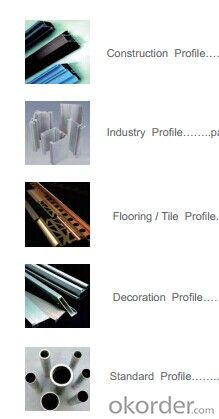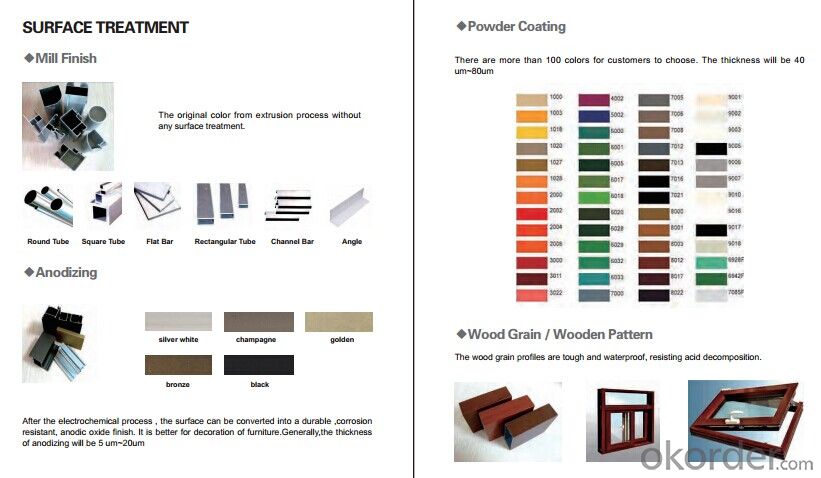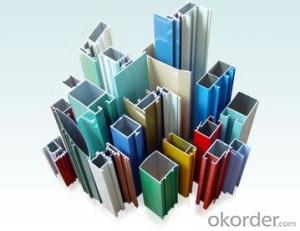Alu Perfil de aluminio for windows
- Loading Port:
- China Main Port
- Payment Terms:
- TT OR LC
- Min Order Qty:
- -
- Supply Capability:
- -
OKorder Service Pledge
OKorder Financial Service
You Might Also Like
Aluminium is a relatively soft,durable, lightweight, ductile and malleablemetal with appearance ranging from silvery to dull gray,depending on the surface roughness. It is nonmagnetic and does not easilyignite. A fresh film of aluminium serves as a good reflector (approximately92%) of visible light and an excellent reflector (as much as98%) of medium and far infrared radiation. The yield strength of pure aluminium is 7–11 MPa,while aluminium alloys have yield strengths ranging from200 MPa to 600 MPa. Aluminium has about one-third the density and stiffnessof steel. It iseasily machined,cast, drawn and extruded.
Alu Profile:
Material | Alloy 6063,6061,6005or according to customer’s choice |
Temper | T3, T4, T5, T6 |
Surface | Anodize, electrophoresis, powder coating, PVDF coating, wood grain painting, matted, etc. |
Length | Coating 6.5 meters, Anodizing 6.5 meters, Mill finish 5 meters |
Application | Industrial, electrical equipment(TV set, air conditioner, refrigerator, computer), decoration,construction, transportation |
Custom Made | We can package following with customer's request. |



FAQ:
1. What is the form of payment?
Normally 30% TT, L/C at sight
2. Type of quotation?
FOB, CFR, CIF
3. Port of loading?
Guangzhou/Shenzhen port
4. Delivery time?
15-20 days after client’s deposit
- Q:30*40 how much aluminum meter?
- 30*40 aluminum tube color of grain price is generally about 13.6-19.8.
- Q:What are the weight capacities of aluminum profiles for shelving systems?
- The weight capacities of aluminum profiles for shelving systems can vary depending on various factors such as the dimensions of the profiles, the design of the shelving system, and the quality of the aluminum used. Generally, aluminum profiles used for shelving systems can support a significant amount of weight. However, it is important to note that the weight capacity of a shelving system also depends on other components such as brackets, connectors, and the type of shelving material used (e.g., wood, glass, or metal shelves). It is recommended to consult the manufacturer or supplier of the specific aluminum profile and shelving system to obtain accurate weight capacity information. They can provide guidelines based on their product specifications, engineering calculations, and testing. Additionally, factors such as proper installation, distribution of weight, and regular maintenance also play a crucial role in ensuring the overall strength and stability of a shelving system.
- Q:Can aluminum profiles be used in display shelving and racking systems?
- Yes, aluminum profiles can definitely be used in display shelving and racking systems. Aluminum is a versatile and lightweight material that offers several advantages for these applications. Its strength-to-weight ratio makes it ideal for constructing sturdy and durable shelving and racking systems. Aluminum profiles can be easily customized and fabricated to meet specific design requirements, allowing for flexibility in creating different shelving configurations. Additionally, aluminum is corrosion-resistant, which is particularly beneficial in environments where moisture or chemicals may be present. The sleek and modern appearance of aluminum profiles also adds an aesthetic appeal to display shelving and racking systems. Overall, aluminum profiles are a popular choice for these applications due to their strength, versatility, and aesthetic qualities.
- Q:What are the different types of gaskets used with aluminum profiles?
- There are several different types of gaskets that are commonly used with aluminum profiles. 1. EPDM (Ethylene Propylene Diene Monomer) Gaskets: These gaskets are made of a synthetic rubber material that is highly resistant to weathering, UV radiation, and ozone exposure. EPDM gaskets are commonly used in outdoor applications where they need to provide a tight seal and withstand harsh environmental conditions. 2. Silicone Gaskets: Silicone gaskets are known for their excellent temperature resistance, making them a popular choice for applications that involve extreme heat or cold. They also have good resistance to chemicals and UV radiation, making them suitable for a wide range of industrial and commercial applications. 3. PVC (Polyvinyl Chloride) Gaskets: PVC gaskets are made of a plastic material that is widely used for its excellent resistance to chemicals, oil, and moisture. They are commonly used in applications where a tight seal is required, such as in doors, windows, and other architectural applications. 4. Neoprene Gaskets: Neoprene gaskets are made of a synthetic rubber material that offers good resistance to oils, chemicals, and weathering. They are commonly used in applications that require both sealing and vibration dampening, such as in machinery and equipment. 5. Nitrile Gaskets: Nitrile gaskets, also known as Buna-N gaskets, are made of a synthetic rubber material that offers excellent resistance to oils, fuels, and solvents. They are commonly used in automotive and industrial applications where resistance to oil and fuel is crucial. These are just a few examples of the different types of gaskets that can be used with aluminum profiles. The choice of gasket will depend on the specific requirements of the application, including the desired level of sealing, environmental conditions, and chemical compatibility.
- Q:Are aluminum profiles suitable for use in mining and construction equipment?
- Yes, aluminum profiles are suitable for use in mining and construction equipment. Aluminum offers a unique set of properties that make it highly suitable for these industries. Firstly, aluminum is lightweight, which helps in reducing the overall weight of the equipment, making it easier to transport and maneuver on construction sites or in mining operations. This lightweight nature also allows for increased fuel efficiency, reducing operational costs. Additionally, aluminum profiles have excellent corrosion resistance, which is crucial in these industries where equipment may be exposed to harsh weather conditions or corrosive substances. This resistance to corrosion ensures that the equipment remains durable and long-lasting, even in challenging environments. Furthermore, aluminum profiles can be easily fabricated and customized to suit specific requirements. This flexibility in design allows for the creation of complex shapes and structures, enabling the construction of equipment with optimal strength and functionality. Moreover, aluminum profiles have high thermal conductivity, which effectively dissipates heat generated during mining and construction operations. This property is essential in preventing overheating or damage to the equipment and ensures efficient performance even in intense working conditions. Overall, the combination of lightweight, corrosion resistance, versatility, and thermal conductivity makes aluminum profiles a suitable choice for use in mining and construction equipment.
- Q:What are the advantages of using aluminum profiles in the defense industry?
- Using aluminum profiles in the defense industry offers several benefits. Firstly, they have a high strength-to-weight ratio, meaning they are strong and durable while remaining lightweight. This is crucial in the defense industry, where reducing weight is important for improving mobility and saving fuel. Secondly, aluminum profiles have exceptional corrosion resistance. This is advantageous in defense applications where equipment is exposed to harsh environments like saltwater or extreme weather. The corrosion resistance ensures the equipment remains functional and reliable for long periods, reducing maintenance needs and increasing component lifespan. Additionally, aluminum profiles are highly malleable and can be easily shaped into complex designs. This versatility allows for greater design flexibility in defense applications, creating intricate and customized components. Moreover, aluminum profiles can be easily combined with other materials like composites or steel, expanding their potential uses in the defense industry. Another advantage of aluminum profiles is their excellent thermal conductivity. Compared to other metals, aluminum has a high thermal conductivity, enabling efficient heat dissipation in defense equipment. This is crucial in applications where thermal management is critical, such as electronic systems or high-performance vehicles. Effective heat dissipation ensures the reliability and longevity of sensitive components. Lastly, aluminum is a widely available and cost-effective material. It is abundant in nature and can be easily extracted, making it readily accessible for defense manufacturing. Furthermore, its lower cost compared to metals like titanium or steel makes it an economical choice for defense applications. This allows for cost-effective production of large quantities of components without compromising quality or performance. In conclusion, the advantages of using aluminum profiles in the defense industry include their high strength-to-weight ratio, corrosion resistance, versatility in fabrication, excellent thermal conductivity, and cost-effectiveness. These characteristics make aluminum profiles an ideal choice for various defense applications, contributing to enhanced performance, durability, and cost-efficiency in this critical sector.
- Q:the middle of the following is a groove structure, as if you can not bolt hole, then how to install the rail on it? What's the use of flat sealing strips and slip bars embedded inside? Is it necessary to mount the guide rail on the aluminum profile, you can choose more than 6060 of the profiles, the middle is flat structure, and then drill holes in the bolt connection rail Thanks
- Use the T nut (in the T groove) to fit the rail, the flat sealing strip, and the slip bar embedded in it for dust, waterproof, oil proof and so on.Guide (TTW): metal or other materials made of grooves or ridges, can withstand, fixed, and guide the movement of devices or equipment, and reduce its friction of a device.
- Q:What are the advantages of using aluminum profiles in the telecommunications infrastructure?
- Using aluminum profiles in the telecommunications infrastructure offers several advantages: 1. Lightweight: Aluminum profiles are much lighter than traditional materials like steel, making them easier to transport and install. This reduces labor costs and deployment time. 2. Resistant to corrosion: Aluminum has excellent resistance to corrosion, making it ideal for outdoor infrastructure exposed to harsh environmental conditions. It can withstand high humidity and exposure to chemicals. 3. High strength-to-weight ratio: Despite being lightweight, aluminum profiles have a high strength-to-weight ratio. This means they can support heavy equipment and structures while still being relatively light. They are perfect for applications such as antenna mounts and support structures. 4. Easy customization: Aluminum profiles can be easily customized to meet specific design requirements. They can be cut, drilled, or shaped to fit unique specifications, allowing for flexibility in design and installation. 5. Cost-effective: Aluminum profiles are generally more cost-effective compared to materials like steel or fiberglass. They require minimal maintenance, have a long lifespan, and can be recycled, reducing overall costs over the infrastructure's life cycle. 6. Electrical conductivity: Aluminum is an excellent conductor of electricity, making it suitable for telecommunications infrastructure where electrical conductivity is important. 7. Aesthetically pleasing: Aluminum profiles have a sleek and modern appearance, enhancing the overall aesthetics of the telecommunications infrastructure. This is particularly important in urban or residential areas where visual appeal is considered. Overall, the use of aluminum profiles in telecommunications infrastructure offers benefits such as lightweight design, corrosion resistance, high strength-to-weight ratio, customization options, cost-effectiveness, electrical conductivity, and aesthetic appeal. These advantages make aluminum profiles the preferred choice for various components within the telecommunications industry.
- Q:Can aluminum profiles be used in construction?
- Yes, aluminum profiles can be used in construction. Aluminum is a lightweight, durable, and corrosion-resistant material, making it suitable for various construction applications. It is often used in the construction of windows, doors, curtain walls, and roofing systems. Aluminum profiles offer flexibility in design, allowing for the creation of complex shapes and structures. Additionally, aluminum is a sustainable material as it is highly recyclable, making it an environmentally friendly choice for construction projects.
- Q:What are the minimum thickness specifications for aluminum alloy door and window profiles?
- The main force member without the minimum wall thickness of aluminum profile measured door surface treatment not less than 2, the window is not less than 1.4, piecing material, horizontal and vertical should be determined through calculation, please refer to the specific GB8478:2008 Aluminum Alloy "window"
1. Manufacturer Overview |
|
|---|---|
| Location | |
| Year Established | |
| Annual Output Value | |
| Main Markets | |
| Company Certifications | |
2. Manufacturer Certificates |
|
|---|---|
| a) Certification Name | |
| Range | |
| Reference | |
| Validity Period | |
3. Manufacturer Capability |
|
|---|---|
| a)Trade Capacity | |
| Nearest Port | |
| Export Percentage | |
| No.of Employees in Trade Department | |
| Language Spoken: | |
| b)Factory Information | |
| Factory Size: | |
| No. of Production Lines | |
| Contract Manufacturing | |
| Product Price Range | |
Send your message to us
Alu Perfil de aluminio for windows
- Loading Port:
- China Main Port
- Payment Terms:
- TT OR LC
- Min Order Qty:
- -
- Supply Capability:
- -
OKorder Service Pledge
OKorder Financial Service
Similar products
New products
Hot products
Hot Searches
Related keywords





























